HOPE not hate uses cookies to collect information and give you a more personalised experience on our site. You can find more information in our privacy policy. To agree to this, please click accept.
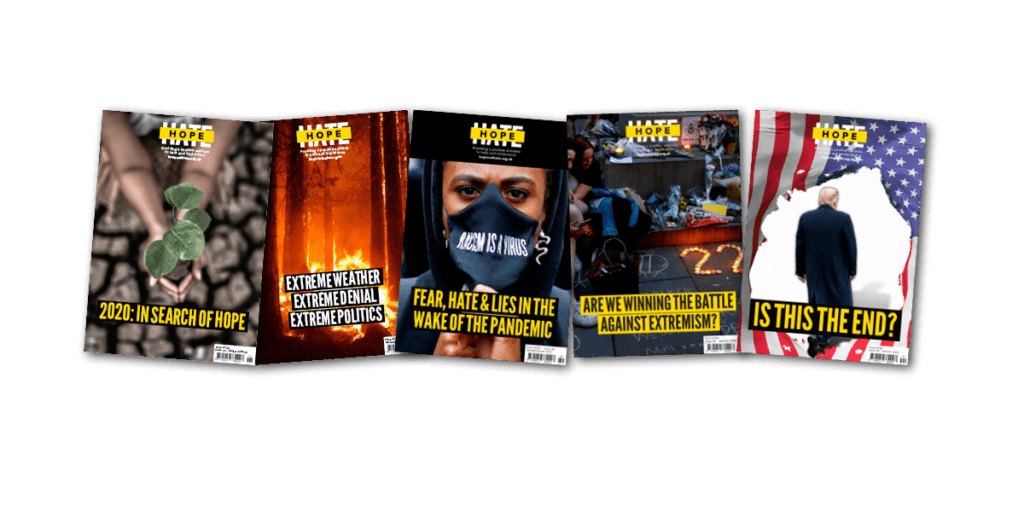
During a town hall hosted by CNN in his hometown of Scranton, Pennsylvania, Joe Biden made a rallying cry for the 2020 election: “this whole election comes down to Park Avenue vs. Scranton”, asserting his working class Scranton roots in opposition to Trump’s luxury Manhattan building.
Indeed, Pennsylvania looks set to be the single most important state for 2020, following 2016’s narrow victory for Donald Trump, who won Pennsylvania by 44,292 votes out of more than 6,000,000 cast, a difference of 0.72% and the narrowest margin in a presidential election for the state in 176 years. This small margin is staggering, considering that Pennsylvania had been more Democratic-leaning than the national popular vote in every presidential election since 1952.
The battle in Pennsylvania – and if Biden is right, of the U.S. – is one that plays on the key political tensions of our time.
Economic inequality has intensified in conjunction with rapidly increasing diversity, and inflated the so-called ‘migration debate’. Economic restructuring towards cities has seen cities become young, thriving multicultural hubs but left many towns and rural areas with older, settled populations and an acute sense of decline.
Access to higher education has opened up, but left poorer students saddled with debt and those who do not make it to university concentrated in the low-paid and precarious offerings of the service and logistics industries. The collapse of traditional industry has been met with a liberal tide of green politics. Increasingly progressive social norms and a rising consciousness of racism’s pervasiveness have been met with cries of political correctness gone mad.
Traditional unionised, democratic strongholds fell to Trump in 2016. Predominantly white, non-graduate populations in towns and rural areas who felt increasingly alienated from the Washington class (of which Clinton was emblematic), found representation in Trump’s plain-speaking, non-PC, nationalist populism. A revival of white American pride spoke to feelings of loss and abandonment by the political system, posing ‘ordinary Americans’ (read: white) against minorities and migrants – while the Dems chased the Black and Hispanic vote.
The issues that decided the election are not simply ‘cultural’ or ‘economic’; they emerge at the intersections of both. They cut across demographic and geographic divides, and shape a society that is increasingly polarised not just by beliefs, but in the ecology which feeds those beliefs.

My work at HOPE not hate has over the last few years centred on better understanding these tensions in the UK context, to challenge the populist threat that they feed, and to offer an alternative – hope. Last year, I was awarded a Churchill Memorial Fellowship to travel to the U.S. and carry out some research on hostility to immigration in small towns across the U.S. where I spend several weeks travelling across the state of Pennsylvania.
This article draws on my experiences of both, bringing together my conversations on both sides of the pond in community centres, gas stations and cafes with exclusive new polling of 1,000 Pennsylvanians, carried out ahead of the election by Hanbury strategy.
Pennsylvania, as a key swing state, is divided. Our polling finds Trump and Biden voters in the state poles apart – 94% of Trump voters believe that he is a strong leader who is making America great again, while 93% of Biden voters say that President Trump is a divisive and dangerous leader who is damaging America.
Immigration (31%), terrorism (29%) , the state of the global economy (28%) and child trafficking (26%) are almost on a par with Covid-19 (46%) on Trump voters’ list of most important issues. Biden voters are more preoccupied with Covid-19 (67%), climate change (39%) and the affordability of healthcare. Biden voters want a Pennsylvania where everyone thrives (71%) and that works for all, not just a wealthy few (86%), while Trump voters want a state with smaller government (43%) and free enterprise (625).
On race relations, Trump voters are three times more likely (68%) than Biden voters (23%) to think that white people are as discriminated against as much as people of colour, while 12% of Trump voters say the president is racist, 91% of Biden voters say the same. 60% of Trump voters say that they are ‘very worried’ about the radical left, while Biden voters are more likely to be ‘very worried’ about Militias and White supremacists (58%).
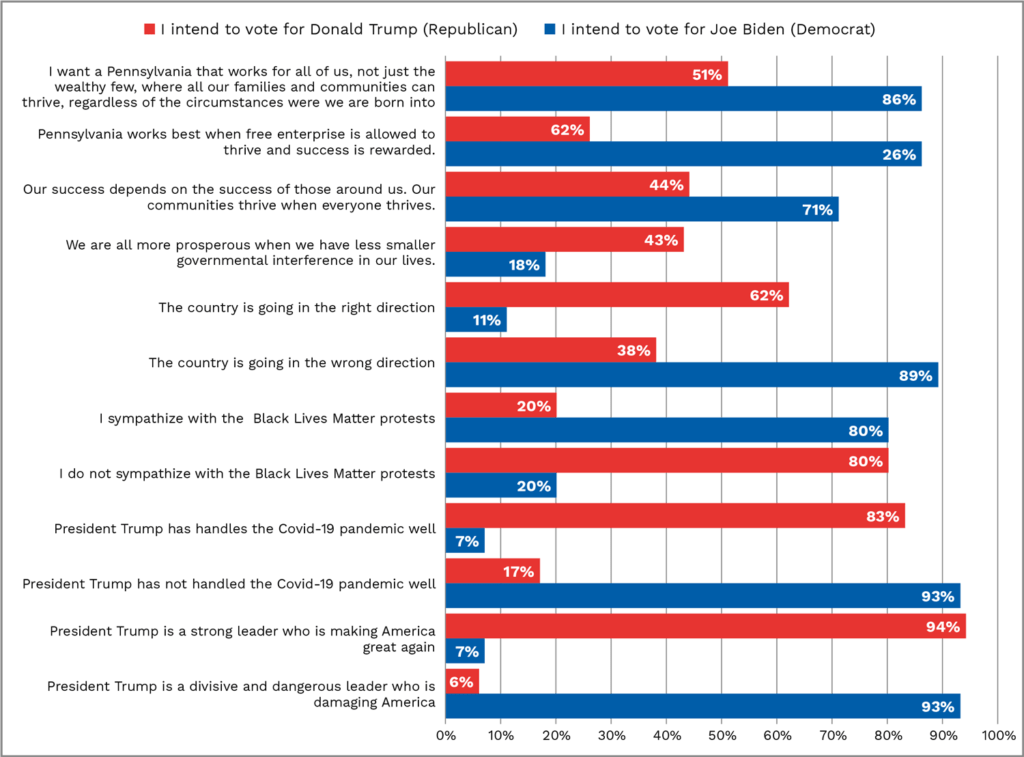
Pennsylvania’s electorate looks set to be more favourable to Trump, and our polling finds that Pennsylvania’s politics lean to the right, with around a third (32%) considering themselves either very conservative (10%) or conservative (22%), around a third who consider themselves moderates (34%) and a minority who see themselves as liberal (17%) or progressive (4%). Non-Hispanic white people without bachelor’s degrees make up 55% of Pennsylvania’s population age 25 or older.
According to the Centre for American Progress, in 2016 voters were 84% white – 54% of the total vote was white non-college-educated and 30% were white college-educated. Pennsylvania trends older, with 27% of the state in the 45-64 age group. Union membership in the state has fallen from 27.5% in 1983 to 12.0% in 2019.
But Pennsylvania also has deep Democratic roots, and over the years, a lot has changed in economics and society. While associated with the declining American steel industry, industrial agriculture has thrived as one of the states main industries. Census data shows that some districts have seen rapid demographic shifts – as much as a 46% increase in their Asian population and 42% increase in their Hispanic population since 2010. And the state has been hit hard by Covid-19, as cases continue to rise.
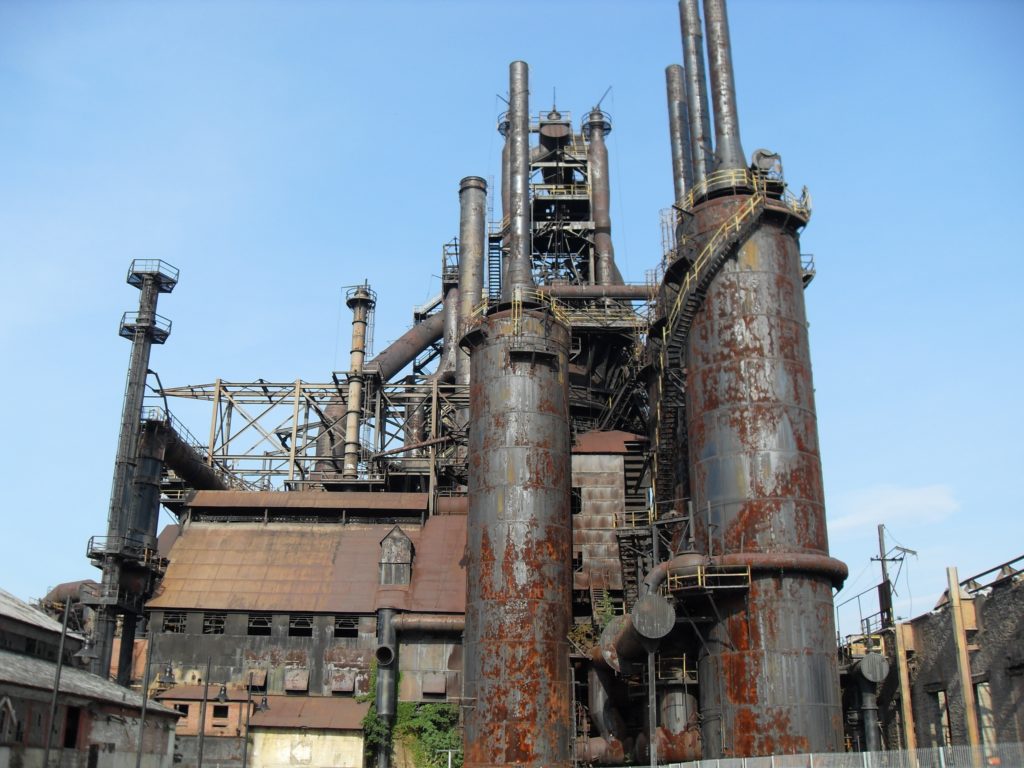
Pennsylvania’s political geography was once described by political commentator James Carville as, “Philadelphia and Pittsburgh with Alabama in between”.
Historically the state has been divided between the two big cities and their suburbs, more blue collar Pittsburgh in the West and diverse Philadelphia in the East, the blue-collar Northeast Corridor, mining and mill towns in south-western Pennsylvania, socially conservative rural areas of the centre, and Amish counties in the south-central region – specifically York and Lancaster Counties.
Religious conservatism and older, settled white populations has seen more rural areas lean Red, while the state’s Blue stronghold was ensured by a strong union presence in industrial areas and by white college graduates and minorities in the cities and their suburbs.
But since the 2000s, working-class western and north-eastern Pennsylvania have slowly but surely been getting redder, largely the whiter, less educated areas of the state where traditional industry is in decline. Simultaneously, the affluent, well-educated counties around Philadelphia went from voting for Obama by 10 points in 2012 to voting for Clinton by 14 points. Election maps of Pennsylvania clearly paint a growing urban and suburban to rural and towns divide.
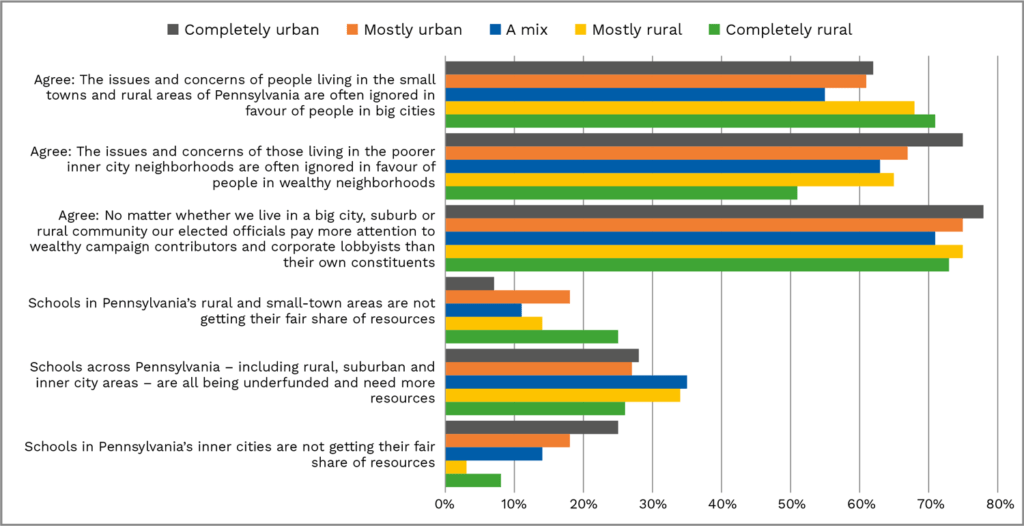
Our polling finds that there is a real sense that small town and rural areas are losing out. Overall, a majority (62%) felt that the issues and concerns of people living in the small towns and rural areas of Pennsylvania are often ignored in favour of people in big cities, including 62% of those living in completely urban areas.
Most (65%) also felt that the issues and concerns of those living in the poorer inner city neighbourhoods are often ignored in favour of people in wealthy neighbourhoods, though this was split between three quarters of those in completely urban areas (75%) and half of those in completely rural areas (51%).
These urban-rural divides reflect some level of resentment among city residents towards rural voters in driven by a rejection of Tump’s election, and among rural residents about a perceived urban snobbery among those who benefit from a centralisation of wealth, but this in no way reflects the antagonism set out in much media coverage.
But the values and outlook of Pennsylvania’s rural and urban voters do indicate some real divides. Almost twice as many rural (41%) as urban (23%) Pennsylvanians think that abortion should be illegal, that a protection of gun ownership should come before gun controls (urban 24% rural 40%), and rural Pennsylvanians are more than twice as likely (36%) as city and suburban residents to believe that marriage should be the preserve of heterosexual couples (16%).
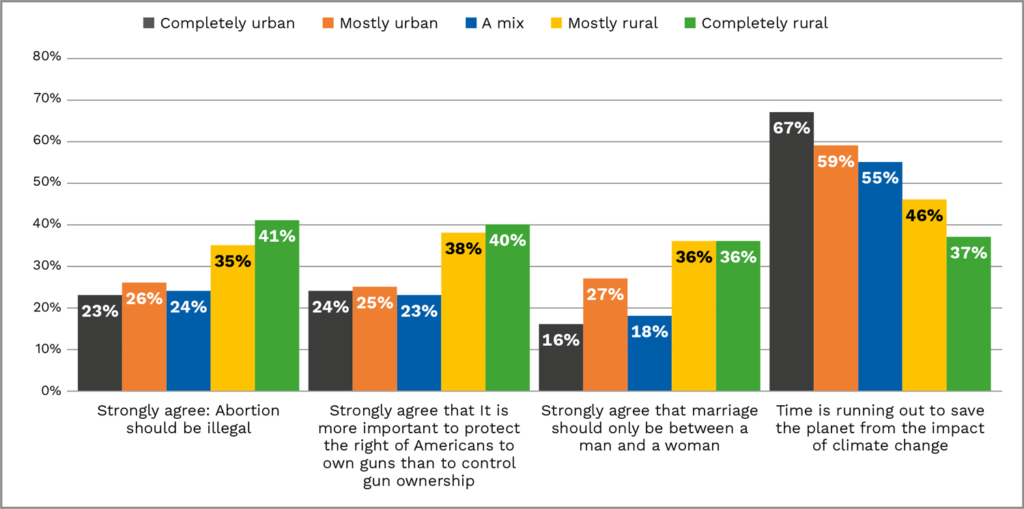
On environmental issues, too, rural and urban Pennsylvanians are miles apart. While a majority of urban residents agree that time is running out to save the planet form the impact of climate change (67%), just over a third (37%) of Pennsylvanians in rural areas feel the same.
This has been considered a key issue in the shift of working class, industrial and post-industrial areas to Trump, as an embrace of progressive green politics among the Democrats fed a sense of political alienation among those who for generations have relied on the state’s less green mining and manufacturing industries.
This gulf in social attitudes is evident in looking at attitudes to race and racism in the U.S. Though less enthusiastic than urban residents, a majority of rural Pennsylvanians agree with a series of statements about inclusion: that there is a place for every kind of person in American society, and that having a wide variety of cultures and backgrounds is part of American culture. Belief in the American dream is alive and well across rural and urban areas.
But when explicitly asked about race and racism, the two groups are poles apart. Pennsylvanians living in completely urban areas are far more likely to sympathise with the BLM protests (63%) than Pennsylvanians in completely rural areas (40%). And while a minority across all places believe that race relations in America are generally good, there is widespread rejection among rural Pennsylvanians that this is a systemic problem.
Just half (50%) believe that systemic racism exists in the U.S. compared to an overwhelming majority (85%) of Pennsylvanians living in cities. A staggering 40% of Pennsylvanians living in completely rural areas say that they feel safer when armed groups of civilians mobilise on the streets of their community in response to BLM.
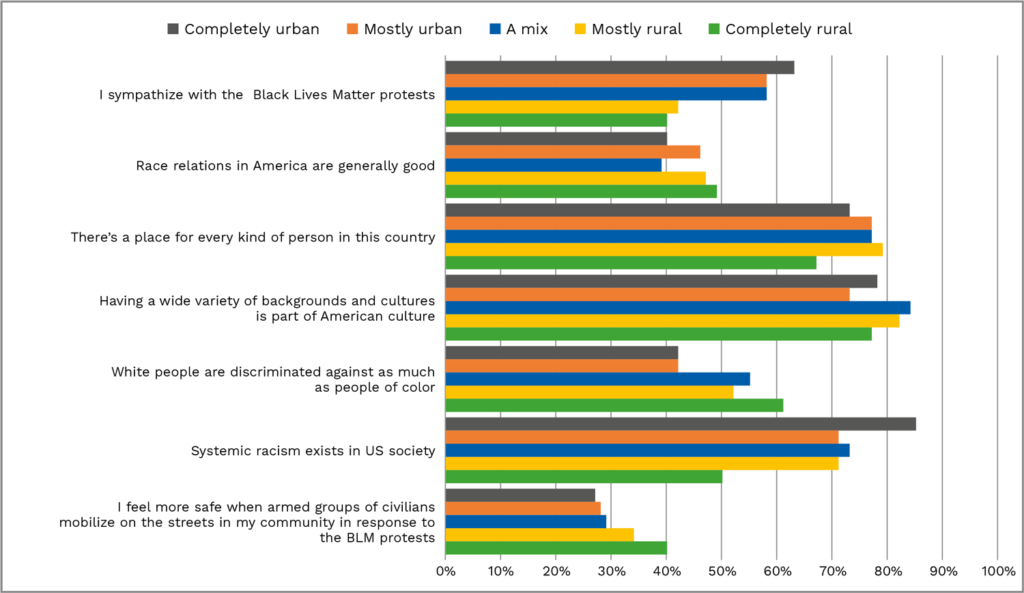
This divide is largely due to the demographics of people living there. Rural Pennsylvania residents are older than urban Pennsylvania residents, while as of 2018, just 9% of the rural population were non-white and/or Hispanic, compared to Philadelphia, whose residents are 44.1% Black, 35.8% white, 13.6% Latino and 7.2% Asian.
Just 3% of rural Pennsylvanians were foreign-born – compared to 8% of Pennsylvanian’s urban population. In 2018, 22% of rural Pennsylvanians who were 25 and older had a bachelor’s degree or higher compared to 34 percent of urban Pennsylvanians of the same age. About 10% of rural and urban adults did not have a high school diploma.
For many rural areas in the U.S. a perceived sense of decline in rural areas feeds feelings of being under threat, with many finding retreat in the politics of Trump and the defensive identity politics of ethno-nationalism. Indeed, our polling shows that a majority of rural Pennsylvanians (61%) believe that white people are discriminated against as much as people of colour.
But Trump’s election has also given many rural Pennsylvanians a feeling of optimism. While fewer than a third (32%) of those in completely urban areas feel that the country is going in the right direction, around half of those in completely rural areas think this is the case.
Rural Pennsylvanians are also more likely to say that they are optimistic for the future (66%), that things are working better for America as a whole than they were five years ago (40%), and more than twice as likely to voice approval of Trump’s handling of the Covid-19 pandemic than those in cities.
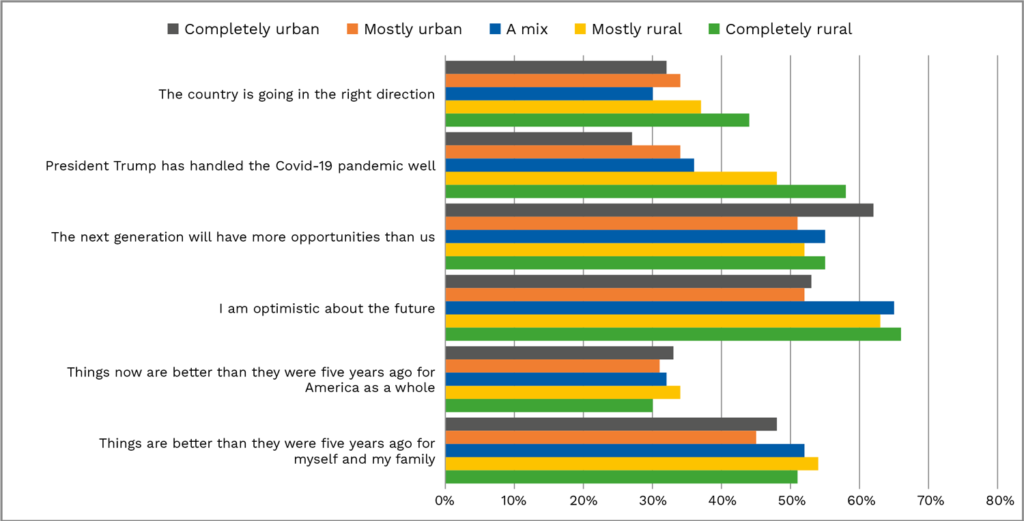
Just as in the UK, growing place-based divides have come to define the political landscape in Pennsylvania. Ageing and shrinking populations, declining high streets and fallen industry have all played a part in feeding resentment and frustration and deepening cultural divides. Nonetheless, this alone won’t make or break the 2020 vote.
Diana Mutz, professor of political science at the University of Pennsylvania, looked at what drove support for Trump in the 2016 election and found that economics alone did not explain the Republican swing seen in some of north-eastern Pennsylvania’s counties was in fact largely down to status threat among those who were white, American and male:
“A lot of the economic decline, the decline in manufacturing that people were referring to, and they talked about the left behind, actually occurred eight or nine years before 2016, and everything we know about how economic shocks influence political behaviour, suggests it doesn’t happen eight years later. So at the time, in the US, in the five years preceding the election, manufacturing employment had actually been increasing in the US. People were better off, not worse off during this period of time.
Mutz explained to me how this concept of the ‘left-behind vote’ became conflated with a demographic analysis that it was poorly educated white voters who tend to have more negative racial attitudes, and tend to be more racially intolerant overall, who had supported Trump and made his Electoral College victory possible.
But it was later that they were able to see that it was really racial attitudes driving things, not people who are economically in decline, whether personally or even in their regions. It was people feeling threatened by demographic change and rapidly increasing diversity.
“There was a sense that globalisation has made us all intertwined a lot more than we used to be. And the idea that we don’t control anything, certainly for the US, which is used to being this dominant superpower, and telling everybody else what to do. That’s something people didn’t like, they liked the idea of America being in the driver’s seat.
But at the same time, the same folks who became Trump voters, were threatened by changes in demographics in the United States, and particularly spent a huge amount of publicity in the United States surrounding the rise of a majority minority nation. This, despite the fact that whites are still going to be the most economically well off is still the best educated and all those kinds of things, which give them more power in American society.”
Indeed, this fear of being pushed off a societal perch rings true in our polling. A majority of Pennsylvanians felt that ‘you cannot be proud of your national identity these days without being called racist’ (55%), including over three quarters (77%) of those intending to vote for Trump; 36% felt that feminism is to blame for making some men feel marginalised and demonised in society, including over half (53%) of those intending to vote Trump, and 44% felt that white people are as discriminated against as much as people of colour, including the vast majority (68%) of those who will vote Trump in 2020.
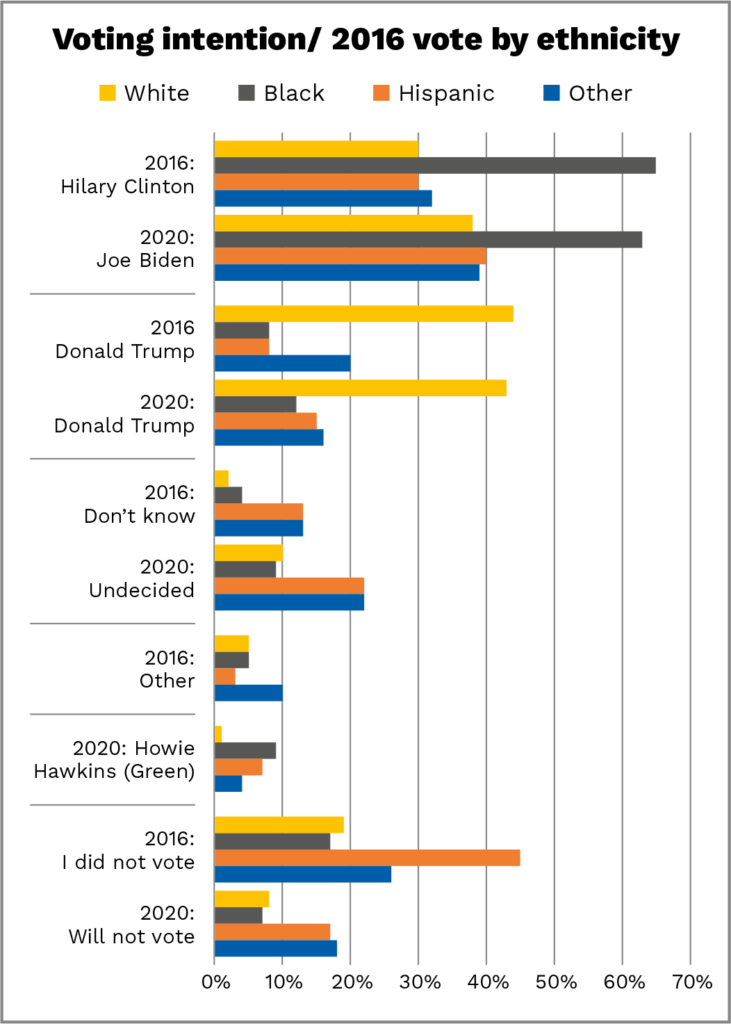
And while Mutz’s research focuses on demographic change across the U.S., it is likely that shifting patterns of immigration – with more and more migrants settling in non-urban areas to work in growing industries of food production, logistics and warehouse work – amplified this sense of rapid change.
From 2000 to 2018, rural Pennsylvania’s population became more racially diverse. In 2000, there were about 168,114 residents, or 5 percent of the total population, who were non-white and/or Hispanic. In 2018, 311,606 rural residents, or 9 percent of the total population, were non-white and/or Hispanic.
While our poll suggests that just 15% of Pennsylvanians consider immigration among the most important issues facing the world today, this rises to 25% among 55-64 year olds, 22% of evangelical Christians, 27% of those who describe their political views as ‘conservative’ or ‘very conservative’, 22% of those living in completely rural areas, and almost a third who intend to vote for Trump (31%).
Though Mutz’s research shows that over his presidency, Trump did not even lead his most ardent supporters, or Republicans in general, toward more strongly anti-immigrant views, it was undeniably a key factor in Trump’s 2016 success.
Our polling finds pessimism among Pennsylvanians about immigration, as overall, a majority (53%) say that immigration has on balance made the country worse, just 30% say it has made the country better. Nonetheless, when asked on their personal feelings towards immigrants, the majority voice positive views.
This chimes with HOPE not hate research on attitudes to immigration in the UK, where immigration is often seen as a national concern, and any talk of numbers feeds perceptions of threat, but when immigration is individualised – when jobs are specified or it is people they know – attitudes soften.
But ahead of 2020, immigration has taken a backseat, with Covid-19 (55%), the availability of affordable healthcare (25%), the state of the economy (23%) and climate change (22%) all coming ahead in Pennsylvanian’s list of most important issues.
So while the anti-immigrant vote has quietened, it could be immigrants that swings Pennsylvania blue. New American Economy showed that in a year, the number of immigrants in Pennsylvania who will be able to cast ballots in November surged 7.9% in a year to 465,395 people. And while it is impossible to say how individuals will vote, this large new voter base are unlikely to turn their support towards a politician who has made his legacy with punitive and callous immigration policy.
| Hazleton, Luzerne County Hazleton is considered by some to be the fault line of America’s immigration debate, sitting within working class Luzerne county, Pennsylvania. Luzerne county, right next to Lakawanna where Biden was born, is traditionally Democratic, but was pivotal in the 2016 election of Donald Trump who won the county by just 26,000 votes. In the summer of 2019, I visited Hazleton, to better understand how the immigration debate was playing out, and followed up with Bob Curry of the Hazleton One Centre just weeks before the election. In 1964, Hazleton was named an ‘all American city’, a place where those who immigrated to make their fortunes from the coal industry worked hard and prospered. But it has since struggled to accommodate change. It is a place that has seen the decline of traditional industry and demographic transformation, while the dramatic landscape surrounding Hazleton paints its past, sweeping valleys of dense forest, dotted with coal operations. The city’s population dropped by 40% between 1940 and 2000, at which point Hazleton housed only a few hundred Hispanic residents, less than 5% of the population. But today, nearly 60% of the city’s 25,000 residents are Hispanic- I’m told that over 90% of pupils in some schools in the city are Hispanic –while 40% are white. The majority of Hispanics living and working in Hazleton today are Dominican, and come as a spill-over from New York, and subsequently through their networks, with most arriving in search of greater security, affordable housing and abundant work in the area’s growing industrial parks. But cultures clashed, as many of the town’s white American residents felt too much change was happening too fast. Community tensions came to a head in 2006. The city, then gripped by debt and rising crime, witnessed the killing of a 29 year-old man. Two undocumented migrants from Dominica were charged with his murder. Former Republican Hazleton Mayor Lou Barletta, a notoriously anti-immigration figure, responded with an ordinance that was passed by the city council, banning landlords from renting to undocumented migrants. The law was quickly overturned by the courts, leaving the city with millions in legal fees, but left a political legacy in whipping up hostility to immigration. Hazleton is a diverse hub in Luzerne county, with the city voting two-to-one for Clinton in 2016 while the wider county (which gave Obama 52% of its vote in 2012) gave Trump 58% in 2016. On the night of Trump’s election, Barletta said “This is a movement that will not die tonight. This movement will live tomorrow because of Donald Trump… there’s a lot in common with what I started here in Hazleton 10 years ago and where we are today”. But Hazleton is not where it was ten years ago. While Luzerne county does not yet have Latino political representation on its council, the Hispanic voter base in town has a huge force to swing things for the county. Last summer, I met up with Bob Curry, manager of the Hazleton Integration centre, established by ‘the most famous Hazletonian’, manager of the Chicago Cubs, Joe Maddon, working to give visibility and support to the city’s growing diversity, and in doing so has helped to shift perceptions among long-standing residents. Among the ringing phones, computer lessons and case notes being written up, Bob was working to ensure that inclusion is ‘the Hazleton way’. Just weeks before the election, I followed up with Bob over video call, who spoke to me about how the immigration question is plating out in Luzerne county. The area was hit hard by the virus, with one of the highest caseload per capita, and had a huge impact on the centre. There have been several large outbreaks in many of the workplaces of the Latino community, and Bob tells me of a meat processing plant with an outbreak of 97 cases, more than 10% of the entire workforce. The affordability of healthcare has become an overwhelming concern for the local population. With school lessons moving online, HIP has adapted quickly to cater for widespread digital poverty in the area. Bob tells me how the awful impact of the coronavirus outbreak has not just taken the heat from the immigration debate, but also helped to soften divides: “There’s such a difference in the last four years. Four years ago, the big talk all over in this county in this city was immigration. But four years later that immigration issue is not the hot button issue in this city at all. It’s still there, it’s always going to be there because of the large number of Latinos that we have in the city, the importance of DACA to some of our city residents, how many family members live here, and things of that nature. But when you talk to the Latinos now, their concerns are starting to sound very familiar to the concerns of everyone else in the county. And the big issue is COVID-19.” And, Bob tells me, that while coronavirus outbreak has had a huge impact, the softening of the immigration debate in Luzerne county has been a long time coming: “It is not revolution, but it is certainly evolution… You know, if you live in the middle of South Dakota, and you don’t know any immigrants, you’re afraid of immigrants. In the city of Hazleton, you know what we call our immigrants? We call them Pedro and Jose. We call them our friends, our neighbors. They’ve been here now long enough. And that’s happening not only here that’s happening all over the country.” Bob’s hopefulness about the softening of divisions looks like it might transfer to the ballot box, with Latino voters signing up to vote, and some turning their backs on Trump’s divisiveness in the face of a global crisis. Speaking with a democratic party activist I had met last year in the county, who asked to remain anonymous, I was told that the Democratic efforts in Luzerne have been: “unlike anything that we have been familiar with, a much more intense effort, much larger, much better organized, mobilized… it would not surprise me to see the city of Hazleton in the democratic column, and the county of Luzerne will not look like it did four years ago.” Efforts across the county have largely targeted Latino voters, with many organising across religious communities, with huge grassroots efforts being made to get out the vote, and a group of people who live across the country but grew up in Luzerne county, some who have left and some who have stayed, have formed a collective of financial support to push this work forward. Our MRP data finds that although those who see themselves as Republicans (36.5%) outweigh the number of people who call themselves democrats (24.3%) in Luzerne county, almost twice as many in the county think the country is going in the wrong direction (61.2%) as think the country is headed in the right direction (61.2%) The battle for Luzerne remains one of the tightest in the country, but it’s clear things are changing. As Bob tells me: “I think it [the immigration debate] has been shown to be exactly what it always was, which is a straw man. It was always absurd.” |
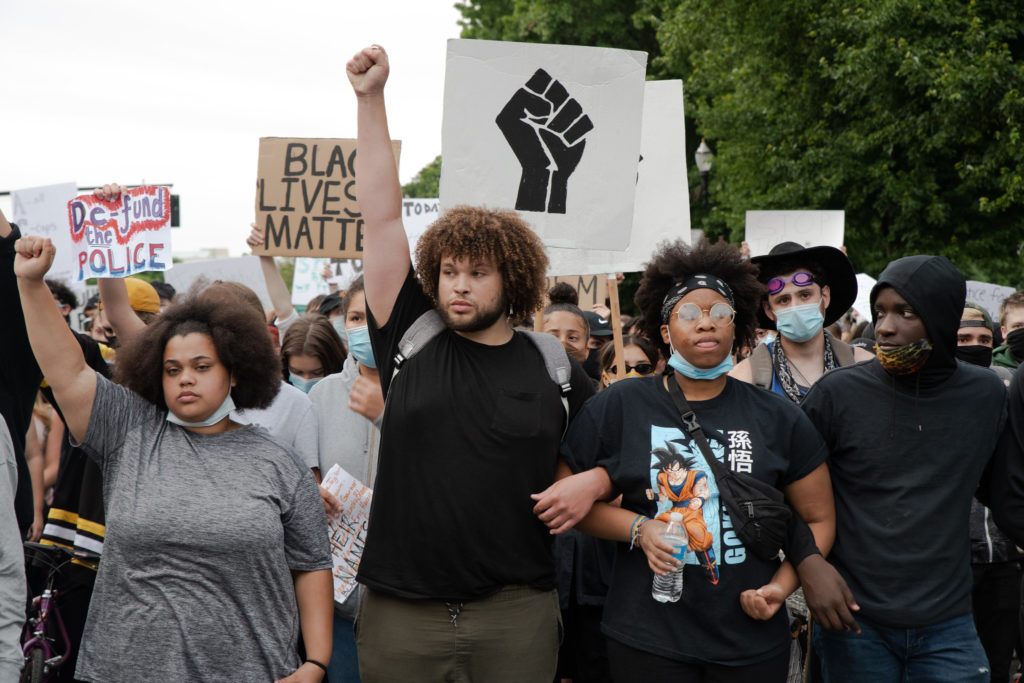
Political divides in Pennsylvania fall heavily along racial divides. Our polling finds that 41% of white Pennsylvanians consider themselves Republican compared to just 10% of Black Pennsylvanians, 12% of Hispanic Pennsylvanians and 17% of Pennsylvanians from other ethnic backgrounds.
Black Pennsylvanians are twice as likely (70%) as white Pennsylvanians (34%) to consider themselves Democrats. But just 40% of Hispanic Pennsylvanians and those of other ethnicities consider themselves to be democrats, instead more likely to see themselves as independents (a third ofHispanic respondents see themselves here) or something else.
Our polling shows that while Trump support holds among white Pennsylvanians, Democrat support among all groups, except Black Pennsylvanians, has increased by almost 10 points. Moreover, voter turnout is set to be far higher in 2020, especially among non-white voters.

Nonetheless, voter registration is far lower among Black (67%), Hispanic (56%) and those of other ethnicities (55%) than it is for whites (85%), and 46% of Pennsylvanians (including 57% of Black Pennsylvanians) agreed that the Republican party is deliberately making it harder for some people to vote.
Moreover, while Covid-19 was clearly the greatest issue for all ethnicities, other key issues for voters vary significantly by ethnicity. Immigration is seen to be a key issue by twice as many white Pennsylvanians (17%) as Black (7%), Hispanic (8%) or those of other ethnicities (7%). Terrorism was largely a concern of white voters (20% listed it ahead of 3% of Black, 10% of Hispanic and 6% of Pennsylvanians of other ethnicities.
Child trafficking was a concern of one in five Pennsylvanians who were white (20%), Black (20%) or of another ethnicity (22%), while this was listed by just 13% of Hispanic Pennsylvanians. But human rights abuses were a bigger concern for Black (22%) and minorities groups (31% of Hispanic and 19% of other ethnicities) than they were for whites (13%).
And minority groups have largely rejected Trump for his racist views. While white Pennsylvanians are clearly polarised over the statement ‘President Trump is a racist’, (48% agree, 52% disagree), 81% of Black Pennsylvanians, 65% of Hispanic Pennsylvanians and 61% of those of other ethnicities think Trump is racist.
Fewer than a third of all non-white Pennsylvanians (28%) say that President Trump is right to say that he has done more than any other President since Abraham Lincoln to help African Americans, while 42% of whites say the same. And there is a consensus across ethnic groups that the use of racist and other bigoted views by elected officials creates an environment in which hate violence is more likely (69% of white, 73% of Black, 65% of Hispanic and 53% of other ethnicities).
This all comes in a year when race and racism have come to the fore of public debate. The brutal killing of George Floyd by a Minnesota police officer sparked enormous reactions across the U.S., one that galvanised long brewing resentment and anger at deep-rooted and systemic racism, anti-Blackness and white supremacy. In Pennsylvania, protests flared in Philadelphia, but away from big media attention, small towns held their own protests, areas where demonstrations are rare, and many in counties where Trump took hold in 2016.
Some of these demonstrations saw bitter counter protests, and at the more extreme, saw shootings of BLM protestors in Cambria and Bedford counties. Among opponents, our polling found that a view that the BLM protests had been violent and unruly has discredited their appeal.
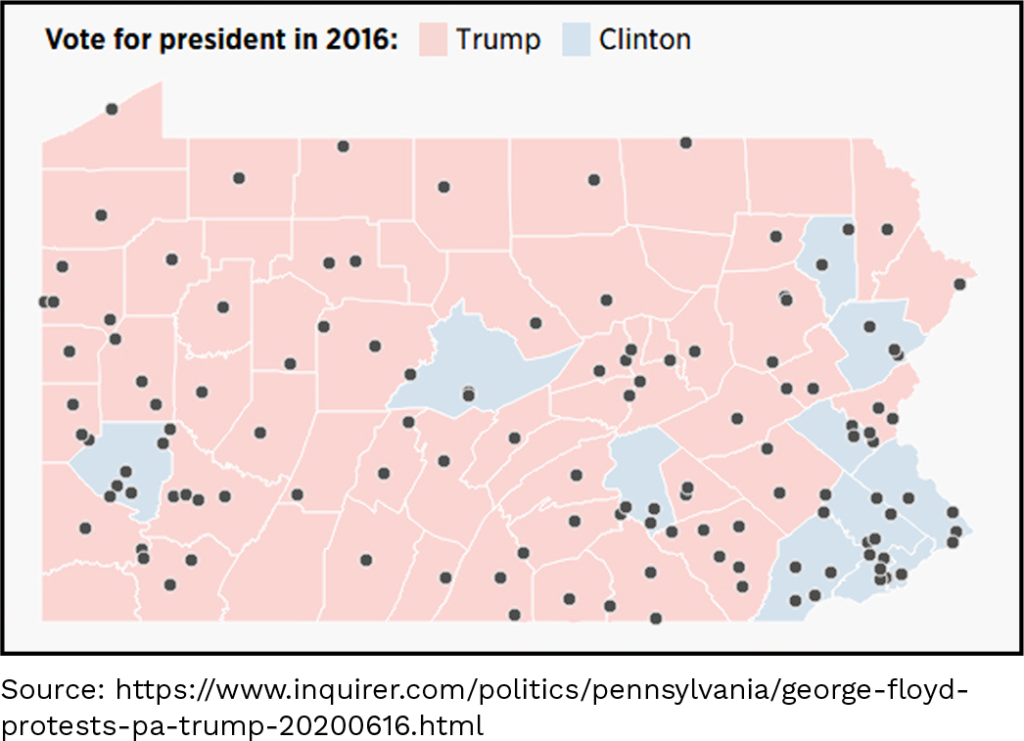
Nearly half – 45% – of Pennsylvanians said that the Black Lives Matter protests are overwhelmingly peaceful, but this fell to 25% of evangelicals, 34% of white respondents, 23% of those living in completely rural areas, and just 14% among those who plan to vote Trump. Almost a third agreed that they feel more safe when armed groups of civilians mobilise on the streets in my community in response to the BLM protests, including 41% of 18-24 year olds, 53% of those who describe their political views as very conservative, and half (50%) of those planning to vote Trump.
At the same time, our polling shows that a majority of Pennsylvanians support the Black Lives Matter protests (53%) and voice positive feelings towards BLM protesters (54%). And support for BLM has, to some extent, cut across Pennsylvania’s polarised political debate, as a third (32%) of those describing their political views as ‘conservative’ or ‘very conservative’ claim to support the movement. This falls away to just 20% of those intending to vote Trump – but given the president’s response to the protests, even this is substantial.
Mutz believes that although it was racism that underpinned Trumps victory, Trump has taken the debate too far to the extreme to maintain support among ‘traditional’, economically conservative republicans, in what she calls, “a kiss of death for the party… the party of racism doesn’t have much of a future in this country”.
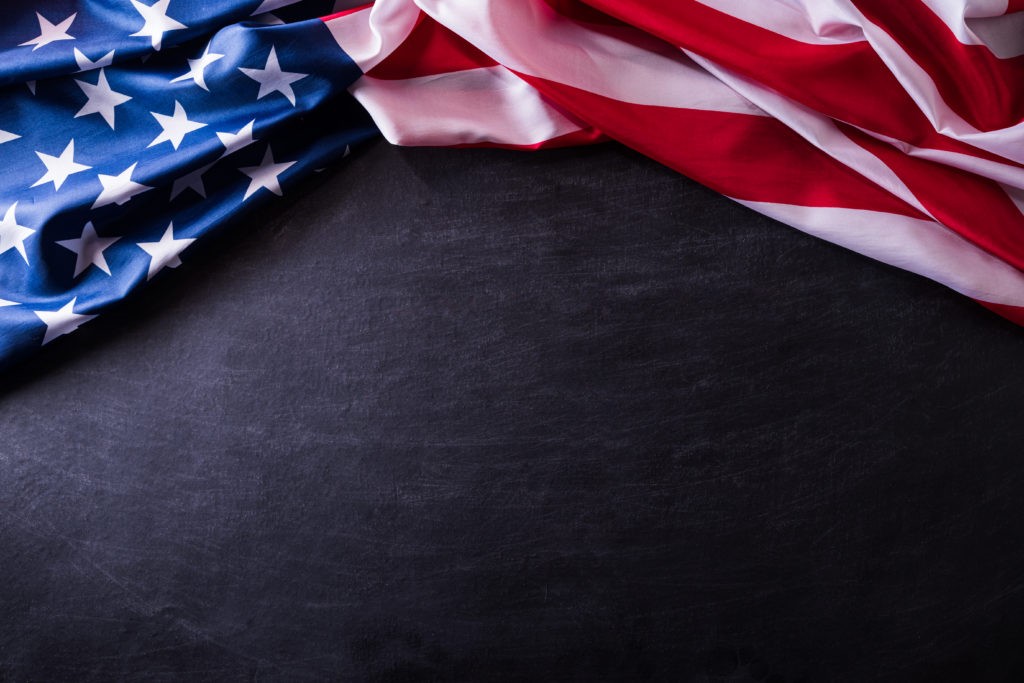
In the race of Scanton vs. Park avenue, Pennsylvania will certainly be one to watch this election – not least as our polling finds a quarter of voters in the state who remain detached or undecided. And the context in which this election is taking place will ensure some challenging choices for those who were once committed to one candidate.
Trump voters are unanimous in their support for the leader, but split on how the pandemic is being handled, which could weaken his support. While 50% believe that you can’t get the economy back up and running if you don’t control the spread of Covid-19, 30% disagree, and more than a third (35%) believe that the coronavirus outbreak is exposing great inequality in American society.
But whatever the outcome, Pennsylvania is one to watch in terms of what it tells us about the state of our politics in 2020, and how key social issues of race, immigration and demographic change can tell us, alongside growing pace based divides, that we have seen both across the US and in the UK.
In this polarised state, if there is one thing that voters agree on, it is concern about the divisions that exist in American society, with over 80% of both Trump and Biden voters concerned about political divides, and worryingly, 39% of Biden voters and 46% of Trump voters in agreement that the US is heading for civil war.

And whatever the outcome, it will be these divisions which carry beyond the election. Trump voters are already sceptical that these elections will be free and fair (24%), while the vast majority of those planning to vote Biden feel the same (88%). Moreover, around half of Trump voters feel that it would be right for Trump to refuse to accept the election result if he lost by a small margin.
Of course, these are just statements, and there is no indication that those who agree with these statements would act upon them. Nonetheless, whoever takes office from 2020 will face a tough transition in the midst of a global pandemic that will place the state government at a $5 billion shortfall over two years.
It is in this context that the key issues moving Pennsylvania – industrial decline and economic uncertainty, urban-rural divides, immigration and race relations could once again rise to the fore. Scranton vs. Park Avenue will not just tell us the story of 2020, but of modern American society.

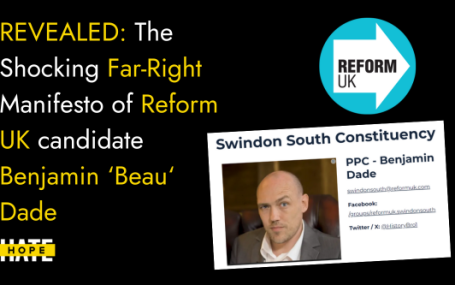
A Reform Party candidate fantasised about deporting “millions” of British citizens to “rid itself of the foreign plague we have been diseased with”. UPDATE: Reform…